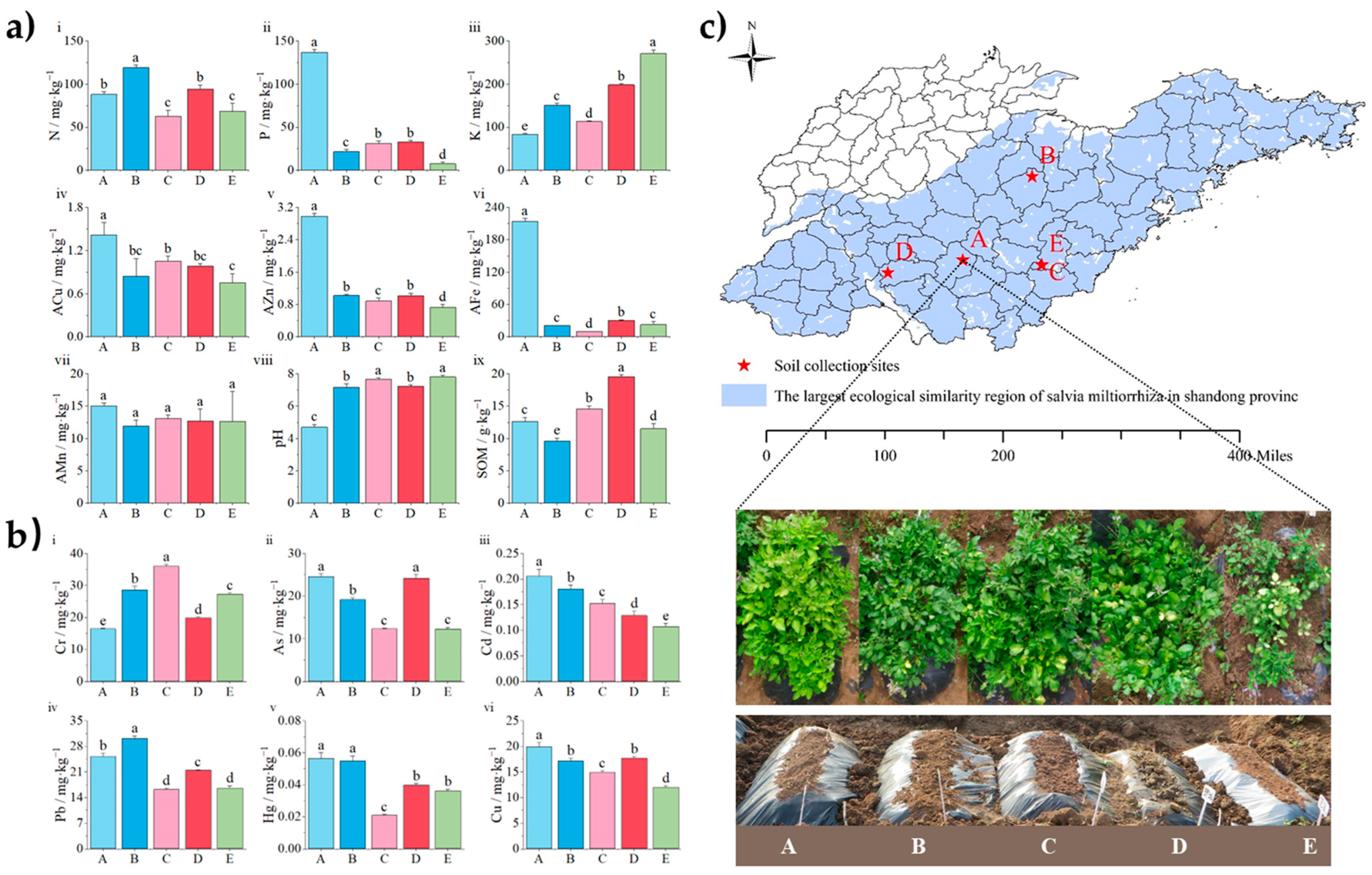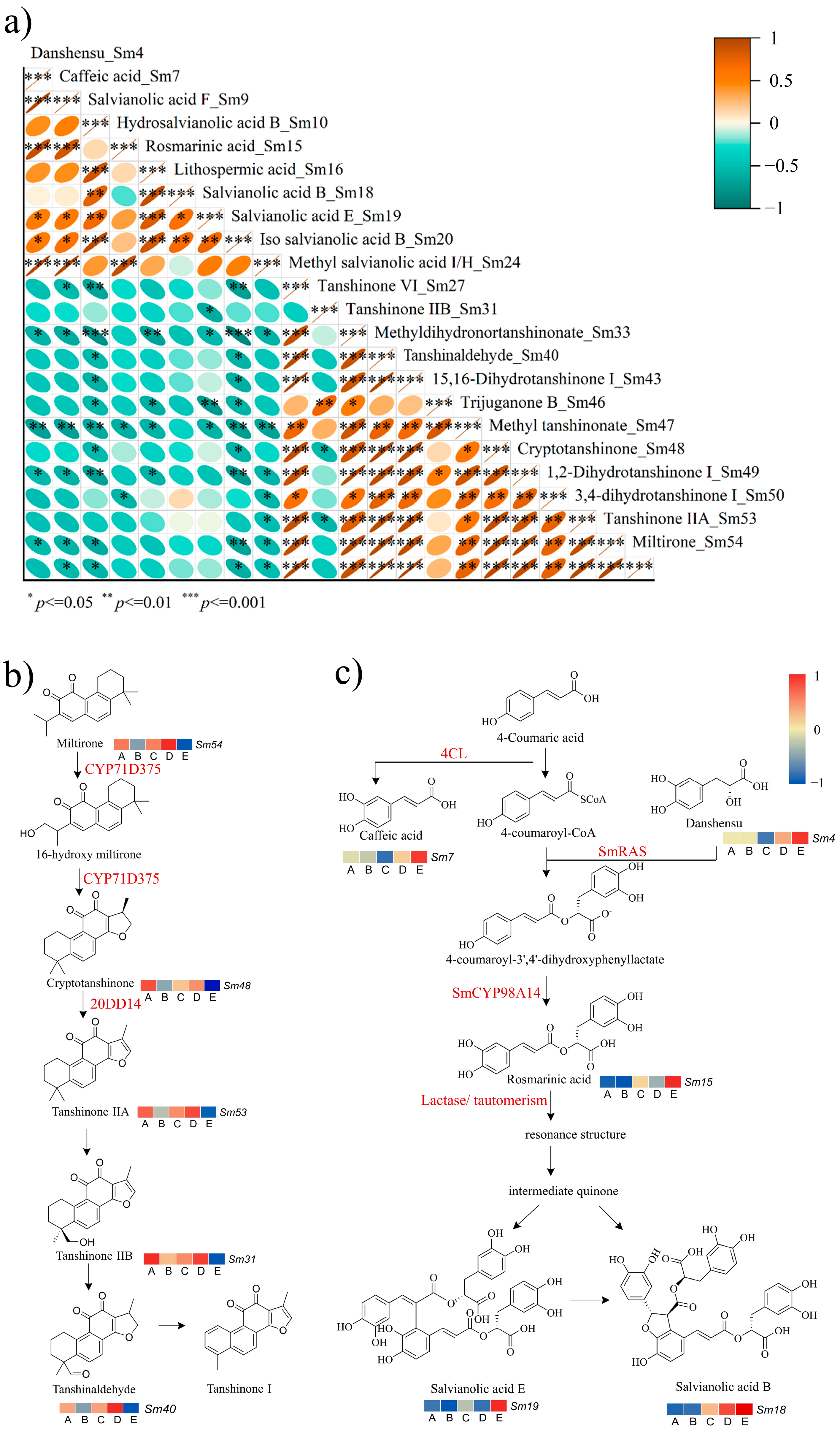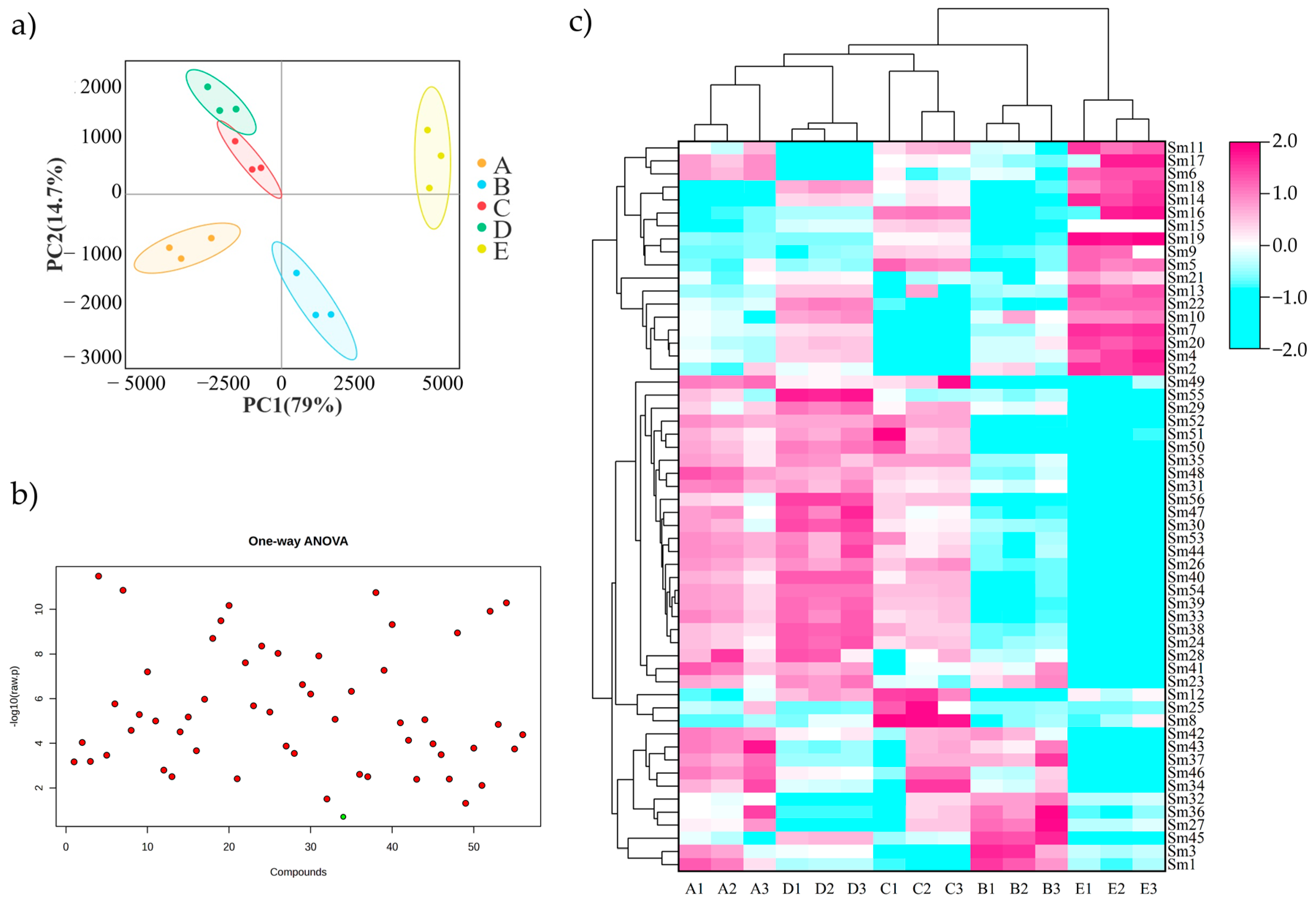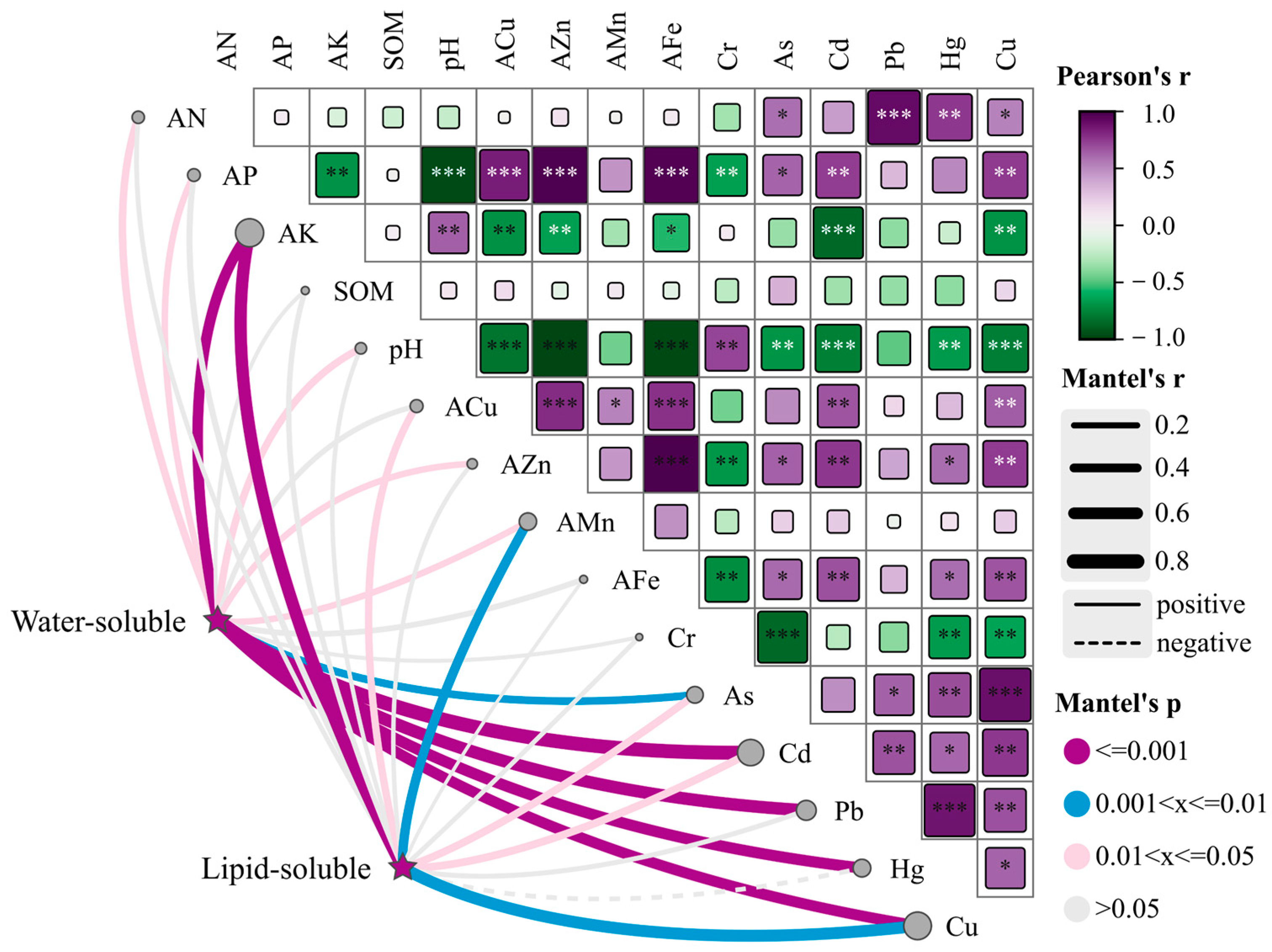UHPLC-QTOF-MS-Based Targeted Metabolomics Provides Novel Insights into the Accumulative Mechanism of Soil Types on the Bioactive Components of Salvia miltiorrhiza
Abstract
1. Introduction
2. Results
2.1. Comparative Analysis of Different Soil Factors from the Five Soils
2.2. Changes in Salvianolic Acid B and Tanshinone IIA in Different Soils
2.3. The Biosynthetic Pathways of Salvianolic Acid B and Tanshinone I of SMB Planted in Different Soils Were Different
2.4. Chemometrics Analysis
2.5. Correlation Analysis of SMB Components and Soil Factors
2.6. Soil Drivers of Water- and Lipid-Soluble Constituents of SMBs
3. Discussion
4. Materials and Methods
4.1. Study Sites
4.2. Soil Collection and Experimental Set-Up
4.3. Plant Materials
4.4. Soil Sampling and Elemental Analysis
4.5. Extraction and UHPLC-QTOF-MS Analysis
4.6. Statistical Analysis
5. Conclusions
Supplementary Materials
Author Contributions
Funding
Institutional Review Board Statement
Informed Consent Statement
Data Availability Statement
Conflicts of Interest
References
- Ren, J.; Fu, L.; Nile, S.H.; Zhang, J.; Kai, G. Salvia miltiorrhiza in Treating Cardiovascular Diseases: A Review on Its Pharmacological and Clinical Applications. Front. Pharmacol. 2019, 10, 753. [Google Scholar] [CrossRef] [PubMed]
- Kum, K.Y.; Kirchhof, R.; Luick, R.; Heinrich, M. Danshen (Salvia miltiorrhiza) on the Global Market: What Are the Implications for Products’ Quality? Front. Pharmacol. 2021, 12, 621169. [Google Scholar] [CrossRef]
- Hou, M.; Yu, D.; Chen, J.; Chen, W.; Liu, L.; Li, X. Optimization of Standardized Breeding System of Salvia miltiorrhiza Seedlings by Orthogonal Design. Lishizhen Med. Mater. Medica Res. 2023, 34, 2744–2748. [Google Scholar]
- Bibbins-Domingo, K.; Grossman, D.C.; Curry, S.J.; Davidson, K.W.; Epling, J.W.; García, F.A.; Gillman, M.W.; Kemper, A.R.; Krist, A.H.; Kurth, A.E.; et al. Statin Use for the Primary Prevention of Cardiovascular Disease in Adults: US Preventive Services Task Force Recommendation Statement. JAMA 2016, 316, 1997–2007. [Google Scholar] [CrossRef]
- Shi, M.; Huang, F.; Deng, C.; Wang, Y.; Kai, G. Bioactivities, Biosynthesis and Biotechnological Production of Phenolic Acids in Salvia miltiorrhiza. Crit. Rev. Food Sci. Nutr. 2019, 59, 953–964. [Google Scholar] [CrossRef]
- Chen, M.; Cai, Y.; Zhang, W.; Chen, Z.; Shi, Z.; He, C. Recent Insights into the Biological Activities and Drug Delivery Systems of Tanshinones. IJN 2016, 2016, 121–130. [Google Scholar] [CrossRef]
- Wang, X.; Morris-Natschke, S.L.; Lee, K. New Developments in the Chemistry and Biology of the Bioactive Constituents of Tanshen. Med. Res. Rev. 2007, 27, 133–148. [Google Scholar] [CrossRef] [PubMed]
- Ansari, M.A.; Khan, F.B.; Safdari, H.A.; Almatroudi, A.; Alzohairy, M.A.; Safdari, M.; Amirizadeh, M.; Rehman, S.; Equbal, M.J.; Hoque, M. Prospective Therapeutic Potential of Tanshinone IIA: An Updated Overview. Pharmacol. Res. 2021, 164, 105364. [Google Scholar] [CrossRef] [PubMed]
- Jia, Y.; Yao, D.; Bi, H.; Duan, J.; Liang, W.; Jing, Z.; Liu, M. Salvia miltiorrhiza Bunge (Danshen) Based Nano-Delivery Systems for Anticancer Therapeutics. Phytomedicine 2024, 128, 155521. [Google Scholar] [CrossRef]
- Li, W.; Liu, K.; Tao, X.; Zhao, S.; Mu, F.; Chen, S.; Wang, W.; Li, J.; Lu, X.; Bai, Y.; et al. Application of Mixture Design for Optimum Cardio Protection Efficacy of Mixtures of Salvianolic Acid A, Salvianolic Acid B and Danshensu from Salvia miltiorrhiza. Ind. Crop. Prod. 2023, 192, 116095. [Google Scholar] [CrossRef]
- Zhang, L.; Tao, S.; Zhang, Y.; Yang, Y.; Peng, F.; Liao, H.; Mao, C.; Wan, X.; Wu, Y.; Xu, Z.; et al. Study on the Effect of Compound Cultivation on the Growth Feature and Active Ingredients Content of Salvia miltiorrhiza. Front. Plant Sci. 2024, 14, 1238896. [Google Scholar] [CrossRef] [PubMed]
- Bruun, T.B.; De Neergaard, A.; Burup, M.L.; Hepp, C.M.; Larsen, M.N.; Abel, C.; Aumtong, S.; Magid, J.; Mertz, O. Intensification of Upland Agriculture in Thailand: Development or Degradation? Land Degrad. Dev. 2017, 28, 83–94. [Google Scholar] [CrossRef]
- Rodríguez Sousa, A.A.; Muñoz-Rojas, J.; Brígido, C.; Prats, S.A. Impacts of Agricultural Intensification on Soil Erosion and Sustainability of Olive Groves in Alentejo (Portugal). Landsc. Ecol. 2023, 38, 3479–3498. [Google Scholar] [CrossRef]
- Su, J.; Wang, Y.; Bai, M.; Peng, T.; Li, H.; Xu, H.-J.; Guo, G.; Bai, H.; Rong, N.; Sahu, S.K.; et al. Soil Conditions and the Plant Microbiome Boost the Accumulation of Monoterpenes in the Fruit of Citrus Reticulata “Chachi”. Microbiome 2023, 11, 61. [Google Scholar] [CrossRef]
- Tabassum, N.; Ahmed, H.I.; Parween, S.; Sheikh, A.H.; Saad, M.M.; Krattinger, S.G.; Hirt, H. Host Genotype, Soil Composition, and Geo-Climatic Factors Shape the Fonio Seed Microbiome. Microbiome 2024, 12, 11. [Google Scholar] [CrossRef]
- Ren, Y.; Wang, G.; Su, Y.; Li, J.; Zhang, H.; Han, J. Response of Antioxidant Activity, Active Constituent and Rhizosphere Microorganisms of Salvia miltiorrhiza to Combined Application of Microbial Inoculant, Microalgae and Biochar under Cu Stress. Sci. Total Environ. 2024, 925, 171812. [Google Scholar] [CrossRef]
- Wu, B.; Li, J.; Kuang, H.; Shangguan, Y.; Chen, J. Mercapto-Based Palygorskite Modified Soil Micro-Biology and Reduced the Uptake of Heavy Metals by Salvia miltiorrhiza in Cadmium and Lead Co-Contaminated Soil. J. Environ. Manag. 2023, 345, 118859. [Google Scholar] [CrossRef]
- Yu, H.; Zhang, L.; Yang, R.; Jiang, Y.; Liao, J.; Chai, S.; Deng, X.; Wang, L.; Pu, X.; Zhang, Y.; et al. Integrated Multiomics and Synergistic Functional Network Revealed the Mechanism in the Tolerance of Different Ecotypes of Salvia miltiorrhiza Bge. to Doxycycline Pollution. Environ. Sci. Technol. 2023, 57, 9603–9614. [Google Scholar] [CrossRef] [PubMed]
- Zheng, H.; Fu, X.; Shao, J.; Tang, Y.; Yu, M.; Li, L.; Huang, L.; Tang, K. Transcriptional Regulatory Network of High-Value Active Ingredients in Medicinal Plants. Trends Plant Sci. 2023, 28, 856. [Google Scholar] [CrossRef]
- Afrin, S.; Huang, J.-J.; Luo, Z.-Y. JA-Mediated Transcriptional Regulation of Secondary Metabolism in Medicinal Plants. Sci. Bull. 2015, 60, 1062–1072. [Google Scholar] [CrossRef]
- Lu, S. Biosynthesis and Regulatory Mechanisms of Bioactive Compounds in Salvia miltiorrhiza, a Model System for Medicinal Plant Biology. Crit. Rev. Plant Sci. 2021, 40, 243–283. [Google Scholar] [CrossRef]
- Liu, Q.; Zhao, Y.; Qi, Y.; Zhang, Z.; Hao, P.; Pu, G.; Zhang, Y.; Zeng, Y.; Zhang, Y. A Comprehensive Analytical Platform for Unraveling the Effect of the Cultivation Area on the Composition of Salvia miltiorrhiza Bunge. Ind. Crop. Prod. 2020, 145, 111952. [Google Scholar] [CrossRef]
- Sinkovič, L.; Rakszegi, M.; Pipan, B.; Meglič, V. Compositional Traits of Grains and Groats of Barley, Oat and Spelt Grown at Organic and Conventional Fields. Foods 2023, 12, 1054. [Google Scholar] [CrossRef]
- Zhao, Q.; Song, Z.; Fang, X.; Pan, Y.; Guo, L.; Liu, T.; Wang, J. Effect of Genotype and Environment on Salvia miltiorrhiza Roots Using LC/MS-Based Metabolomics. Molecules 2016, 21, 414. [Google Scholar] [CrossRef] [PubMed]
- He, C.; Han, T.; Liu, C.; Sun, P.; Liao, D.; Li, X. Deciphering the Effects of Genotype and Climatic Factors on the Performance, Active Ingredients and Rhizosphere Soil Properties of Salvia miltiorrhiza. Front. Plant Sci. 2023, 14, 1110860. [Google Scholar] [CrossRef]
- Zhang, X.-D.; Yu, Y.-G.; Yang, D.-F.; Qi, Z.-C.; Liu, R.-Z.; Deng, F.-T.; Cai, Z.-X.; Li, Y.; Sun, Y.-F.; Liang, Z.-S. Chemotaxonomic Variation in Secondary Metabolites Contents and Their Correlation between Environmental Factors in Salvia miltiorrhiza Bunge from Natural Habitat of China. Ind. Crop. Prod. 2018, 113, 335–347. [Google Scholar] [CrossRef]
- Tong, Q.; Zhang, C.; Tu, Y.; Chen, J.; Li, Q.; Zeng, Z.; Wang, F.; Sun, L.; Huang, D.; Li, M.; et al. Biosynthesis-Based Spatial Metabolome of Salvia miltiorrhiza Bunge by Combining Metabolomics Approaches with Mass Spectrometry-Imaging. Talanta 2022, 238, 123045. [Google Scholar] [CrossRef] [PubMed]
- Chinese Pharmacopoeia Commission. Pharmacopoeia of the People’s Republic of China, 2020th ed.; Part 1; China Medical Science Press: Beijing, China, 2020; pp. 230–232. [Google Scholar]
- Ul Haq, F.; Ali, A.; Akhtar, N.; Aziz, N.; Khan, M.N.; Ahmad, M.; Musharraf, S.G. A High-Throughput Method for Dereplication and Assessment of Metabolite Distribution in Salvia Species Using LC-MS/MS. J. Adv. Res. 2020, 24, 79–90. [Google Scholar] [CrossRef] [PubMed]
- Liang, W.; Chen, W.; Wu, L.; Li, S.; Qi, Q.; Cui, Y.; Liang, L.; Ye, T.; Zhang, L. Quality Evaluation and Chemical Markers Screening of Salvia miltiorrhiza Bge. (Danshen) Based on HPLC Fingerprints and HPLC-MSn Coupled with Chemometrics. Molecules 2017, 22, 478. [Google Scholar] [CrossRef]
- Dai, H.; Xiao, C.; Liu, H.; Hao, F.; Tang, H. Combined NMR and LC−DAD-MS Analysis Reveals Comprehensive Metabonomic Variations for Three Phenotypic Cultivars of Salvia miltiorrhiza Bunge. J. Proteome Res. 2010, 9, 1565–1578. [Google Scholar] [CrossRef]
- Jiang, M.; Wang, C.; Zhang, Y.; Feng, Y.; Wang, Y.; Zhu, Y. Sparse Partial-least-squares Discriminant Analysis for Different Geographical Origins of Salvia miltiorrhiza by 1H-NMR-based Metabolomics. Phytochem. Anal. 2014, 25, 50–58. [Google Scholar] [CrossRef] [PubMed]
- Lin, H.-Y.; Lin, T.-S.; Chien, H.-J.; Juang, Y.-M.; Chen, C.-J.; Wang, C.-S.; Lai, C.-C. A Rapid, Simple, and High-Throughput UPLC-MS/MS Method for Simultaneous Determination of Bioactive Constituents in Salvia miltiorrhiza with Positive/Negative Ionization Switching. J. Pharm. Biomed. Anal. 2018, 161, 94–100. [Google Scholar] [CrossRef]
- Dai, H.; Xiao, C.; Liu, H.; Tang, H. Combined NMR and LC-MS Analysis Reveals the Metabonomic Changes in Salvia miltiorrhiza Bunge Induced by Water Depletion. J. Proteome Res. 2010, 9, 1460–1475. [Google Scholar] [CrossRef] [PubMed]
- Cui, G.; Duan, L.; Jin, B.; Qian, J.; Xue, Z.; Shen, G.; Snyder, J.H.; Song, J.; Chen, S.; Huang, L.; et al. Functional Divergence of Diterpene Syntheses in the Medicinal Plant Salvia Miltiorrhiza Bunge. Plant Physiol. 2015, 169, 1607–1618. [Google Scholar] [CrossRef] [PubMed]
- Wendroth, O. Multivariate Analysis of Ecological Data Using CANOCO. Vadose Zone J. 2004, 3, 1057. [Google Scholar] [CrossRef]
- Li, Z.; Xu, S.; Liu, P. Salvia miltiorrhiza Burge (Danshen): A Golden Herbal Medicine in Cardiovascular Therapeutics. Acta Pharmacol. Sin. 2018, 39, 802–824. [Google Scholar] [CrossRef]
- Zhao, H.; Han, B.; Li, X.; Sun, C.; Zhai, Y.; Li, M.; Jiang, M.; Zhang, W.; Liang, Y.; Kai, G. Salvia miltiorrhiza in Breast Cancer Treatment: A Review of Its Phytochemistry, Derivatives, Nanoparticles, and Potential Mechanisms. Front. Pharmacol. 2022, 13, 872085. [Google Scholar] [CrossRef] [PubMed]
- Wei, B.; Sun, C.; Wan, H.; Shou, Q.; Han, B.; Sheng, M.; Li, L.; Kai, G. Bioactive Components and Molecular Mechanisms of Salvia miltiorrhiza Bunge in Promoting Blood Circulation to Remove Blood Stasis. J. Ethnopharmacol. 2023, 317, 116697. [Google Scholar] [CrossRef]
- Chen, X.; Yu, J.; Zhong, B.; Lu, J.; Lu, J.-J.; Li, S.; Lu, Y. Pharmacological Activities of Dihydrotanshinone I, a Natural Product from Salvia miltiorrhiza Bunge. Pharmacol. Res. 2019, 145, 104254. [Google Scholar] [CrossRef]
- Li, H.; Gao, C.; Liu, C.; Liu, L.; Zhuang, J.; Yang, J.; Zhou, C.; Feng, F.; Sun, C.; Wu, J. A Review of the Biological Activity and Pharmacology of Cryptotanshinone, an Important Active Constituent in Danshen. Biomed. Pharmacother. 2021, 137, 111332. [Google Scholar] [CrossRef]
- Liang, H.; Kong, Y.; Chen, W.; Wang, X.; Jia, Z.; Dai, Y.; Yang, X. The Quality of Wild Salvia miltiorrhiza from Dao Di Area in China and Its Correlation with Soil Parameters and Climate Factors. Phytochem. Anal. 2021, 32, 318–325. [Google Scholar] [CrossRef]
- Zhou, Z.; Feng, J.; Huo, J.; Qiu, S.; Zhang, P.; Wang, Y.; Li, Q.; Li, Y.; Han, C.; Feng, X.; et al. Versatile CYP98A Enzymes Catalyse Meta-Hydroxylation Reveals Diversity of Salvianolic Acids Biosynthesis. Plant Biotechnol. J. 2024, 22, 1536–1548. [Google Scholar] [CrossRef] [PubMed]
- Deng, C.; Wang, Y.; Huang, F.; Lu, S.; Zhao, L.; Ma, X.; Kai, G. SmMYB2 Promotes Salvianolic Acid Biosynthesis in the Medicinal Herb Salvia miltiorrhiza. JIPB 2020, 62, 1688–1702. [Google Scholar] [CrossRef] [PubMed]
- Ma, Y.; Cui, G.; Chen, T.; Ma, X.; Wang, R.; Jin, B.; Yang, J.; Kang, L.; Tang, J.; Lai, C.; et al. Expansion within the CYP71D Subfamily Drives the Heterocyclization of Tanshinones Synthesis in Salvia miltiorrhiza. Nat. Commun. 2021, 12, 685. [Google Scholar] [CrossRef] [PubMed]
- Zhang, Y.; Xu, Z.; Ji, A.; Luo, H.; Song, J. Genomic Survey of bZIP Transcription Factor Genes Related to Tanshinone Biosynthesis in Salvia miltiorrhiza. Acta Pharm. Sin. B 2018, 8, 295–305. [Google Scholar] [CrossRef] [PubMed]
- Leng, X.; Kan, H.; Wu, Q.; Li, C.; Zheng, Y.; Peng, G. Inhibitory Effect of Salvia miltiorrhiza Extract and Its Active Components on Cervical Intraepithelial Neoplastic Cells. Molecules 2022, 27, 1582. [Google Scholar] [CrossRef] [PubMed]
- Zhang, H.J.; Li, L.N. Salvianolic Acid I: A New Depside from Salvia cavaleriei. Planta Med. 1994, 60, 70–72. [Google Scholar] [CrossRef]
- Dong, J.; Zhao, W.; Shi, P.; Zhou, M.; Liu, Z.; Wang, Y. Soil Differentiation and Soil Comprehensive Evaluation of in Wild and Cultivated Fritillaria pallidiflora Schrenk. Sci. Total Environ. 2023, 872, 162049. [Google Scholar] [CrossRef]
- Zeng, W.; Wan, X.; Gu, G.; Lei, M.; Yang, J.; Chen, T. An Interpolation Method Incorporating the Pollution Diffusion Characteristics for Soil Heavy Metals—Taking a Coke Plant as an Example. Sci. Total Environ. 2023, 857, 159698. [Google Scholar] [CrossRef]
- Villa, K.; Parmar, J.; Vilela, D.; Sánchez, S. Metal-Oxide-Based Microjets for the Simultaneous Removal of Organic Pollutants and Heavy Metals. ACS Appl. Mater. Interfaces 2018, 10, 20478–20486. [Google Scholar] [CrossRef]
- Guan, Q.; Zhao, R.; Pan, N.; Wang, F.; Yang, Y.; Luo, H. Source Apportionment of Heavy Metals in Farmland Soil of Wuwei, China: Comparison of Three Receptor Models. J. Clean. Prod. 2019, 237, 117792. [Google Scholar] [CrossRef]
- Gavrilescu, M. Enhancing Phytoremediation of Soils Polluted with Heavy Metals. Curr. Opin. Biotechnol. 2022, 74, 21–31. [Google Scholar] [CrossRef] [PubMed]
- Deng, S.; Zhang, X.; Zhu, Y.; Zhuo, R. Recent Advances in Phyto-Combined Remediation of Heavy Metal Pollution in Soil. Biotechnol. Adv. 2024, 72, 108337. [Google Scholar] [CrossRef]
- Yang, Z.; Wang, J.; Wang, W.; Zhang, H.; Wu, Y.; Gao, X.; Gao, D.; Li, X. Physiological, Cytological and Multi-Omics Analysis Revealed the Molecular Response of Fritillaria cirrhosa to Cd Toxicity in Qinghai-Tibet Plateau. J. Hazard. Mater. 2024, 472, 134611. [Google Scholar] [CrossRef]
- Chai, S.; Deng, W.; Yang, J.; Guo, L.; Wang, L.; Jiang, Y.; Liao, J.; Deng, X.; Yang, R.; Zhang, Y.; et al. Physiological and Molecular Mechanisms of ZnO Quantum Dots Mitigating Cadmium Stress in Salvia miltiorrhiza. J. Hazard. Mater. 2024, 470, 134245. [Google Scholar] [CrossRef] [PubMed]
- Bhardwaj, S.; Verma, T.; Raza, A.; Kapoor, D. Silicon and Nitric Oxide-Mediated Regulation of Growth Attributes, Metabolites and Antioxidant Defense System of Radish (Raphanus sativus L.) under Arsenic Stress. Phyton-Int. J. Exp. Bot. 2022, 92, 763–782. [Google Scholar] [CrossRef]
- Lu, T.; Wang, X.; Cui, X.; Li, J.; Xu, J.; Xu, P.; Wan, J. Physiological and Metabolomic Analyses Reveal That Fe3O4 Nanoparticles Ameliorate Cadmium and Arsenic Toxicity in Panax notoginseng. Environ. Pollut. 2023, 337, 122578. [Google Scholar] [CrossRef]
- Wu, J.; Li, X.; Huang, L.; Meng, X.; Hu, H.; Luo, L.; Chen, S. A New GIS Model for Ecologically Suitable Distributions of Medicinal Plants. Chin. Med. 2019, 14, 4. [Google Scholar] [CrossRef]
- Bao, S.D. Analysis of Soil Agrochemica, 3rd ed.; China Agriculture Press: Beijing, China, 2000. [Google Scholar]






| Soil Site | Salvianolic Acid B (%) | Total Tanshinone (%) | Salvianolic Acid B: Total Tanshinone |
|---|---|---|---|
| A | 7.06 ± 0.16 d | 1.00 ± 0.01 a | 7.03 |
| B | 7.11 ± 0.18 d | 0.76 ± 0.03 b | 9.34 |
| C | 8.43 ± 0.04 c | 0.95 ± 0.04 a | 8.91 |
| D | 9.15 ± 0.07 b | 1.03 ± 0.03 a | 8.87 |
| E | 9.69 ± 0.19 a | 0.61 ± 0.01 c | 15.99 |
| Number | Patient ID | tR (min) | Mass Ion (m/z) | Data-Dependent MS Data (m/z) | Identidication | Cite |
|---|---|---|---|---|---|---|
| 1 | Sm4 | 3.49 | [M − H]− 197.05 | 174.96, 146.97 | Danshensu | [24,30,31] |
| 2 | Sm7 | 7.00 | [M − H]− 179.03 | 164.93, 135.04, 104.96 | Caffeic acid | [30,31] |
| 3 | Sm9 | 9.86 | [M + Na]+ 337.10 | 302.97, 286.99, 247.00, 231.05 | Salvianolic acid F | [30,31] |
| 4 | Sm10 | 11.56 | [M − H]− 735.16 | 735.16, 294.89, 174.96, 146.97 | Hydrosalvianolic acid B | [30] |
| 5 | Sm15 | 12.70 | [M − H]− 359.08 | 197.04, 161.02 | Rosmarinic acid | [24,30,31,32,33,34] |
| 6 | Sm16 | 13.06 | [M − H]− 537.11 | 493.12, 294.89, 174.96, 146.97 | Lithospermic acid | [24,31,34] |
| 7a | Sm18 | 13.81 | [M − H]− 717.16 | 635.08, 294.89, 174.96, 146.97 | Salvianolic acid B | [30,31,32,33] |
| 8 | Sm19 | 14.23 | [M + Na]+ 741.15 | 425.09, 205.06 | Salvianolic acid E | [24] |
| 9 | Sm20 | 14.8 | [M − H]− 717.15 | 551.13, 362.88, 226.92, 174.96 | Iso salvianolic acid B | [30] |
| 10 | Sm24 | 15.61 | [M − H]− 551.12 | 424.85, 248.90, 226.92, 180.91 | Methyl salvianolic acid I/H | [30] |
| 11 | Sm27 | 16.54 | [M + Na]+ 319.10 | 301.08, 279.10, 261.06,173.01 | Tanshinone VI | [30] |
| 12 | Sm31 | 18.21 | [M + H]+ 274.27 | 212.12, 173.01, 125.99, 110.01 | Tanshinone IIB | [30,31,35] |
| 13 | Sm33 | 19.50 | [M + H]+ 341.14 | 212.12, 173.01, 143.00, 125.99 | Methyldihydronortanshinonate | [30] |
| 14 | Sm40 | 20.37 | [2M + H]+ 619.31 | 441.45, 321.15, 205.06 | Tanshinaldehyde | [30,31] |
| 15 | Sm43 | 21.19 | [M + H]+ 279.10 | 212.12, 173.01, 143.00, 125.99 | 15,16-Dihydrotanshinone I | [30] |
| 16 | Sm46 | 22.01 | [M + H]+ 281.11 | 173.01, 125.99 | Trijuganone B | [30,31,35] |
| 17 | Sm47 | 22.50 | [M + H]+ 339.12 | 212.12, 173.01, 143.00, 125.99 | Methyl tanshinonate | [30] |
| 18 | Sm48 | 24.16 | [M + H]+ 297.15 | 279.00, 251.00 | Cryptotanshinone | [29,30,33] |
| 19 | Sm49 | 25.22 | [M + H]+ 279.10 | 212.12, 173.01, 143.00, 125.99 | 1,2-Dihydrotanshinone I | [30] |
| 20 | Sm50 | 25.36 | [M + H]+ 279.10 | 212.12, 173.01, 143.00, 125.99 | 3,4-dihydrotanshinone I | [30] |
| 21 a | Sm53 | 27.24 | [M + H]+ 295.15 | 125.99 | Tanshinone IIA | [24,29,30,31,32,33,35] |
| 22 | Sm54 | 28.11 | [M + H]+ 283.17 | 212.12, 202.09, 125.99, 110.01 | Miltirone | [31,35] |
Disclaimer/Publisher’s Note: The statements, opinions and data contained in all publications are solely those of the individual author(s) and contributor(s) and not of MDPI and/or the editor(s). MDPI and/or the editor(s) disclaim responsibility for any injury to people or property resulting from any ideas, methods, instructions or products referred to in the content. |
© 2024 by the authors. Licensee MDPI, Basel, Switzerland. This article is an open access article distributed under the terms and conditions of the Creative Commons Attribution (CC BY) license (https://creativecommons.org/licenses/by/4.0/).
Share and Cite
Hou, M.; Gao, D.; Chen, W.; Jiang, W.; Yu, D.; Li, X. UHPLC-QTOF-MS-Based Targeted Metabolomics Provides Novel Insights into the Accumulative Mechanism of Soil Types on the Bioactive Components of Salvia miltiorrhiza. Molecules 2024, 29, 4016. https://doi.org/10.3390/molecules29174016
Hou M, Gao D, Chen W, Jiang W, Yu D, Li X. UHPLC-QTOF-MS-Based Targeted Metabolomics Provides Novel Insights into the Accumulative Mechanism of Soil Types on the Bioactive Components of Salvia miltiorrhiza. Molecules. 2024; 29(17):4016. https://doi.org/10.3390/molecules29174016
Chicago/Turabian StyleHou, Mengmeng, Dan Gao, Weixu Chen, Wenjun Jiang, Dade Yu, and Xiwen Li. 2024. "UHPLC-QTOF-MS-Based Targeted Metabolomics Provides Novel Insights into the Accumulative Mechanism of Soil Types on the Bioactive Components of Salvia miltiorrhiza" Molecules 29, no. 17: 4016. https://doi.org/10.3390/molecules29174016
APA StyleHou, M., Gao, D., Chen, W., Jiang, W., Yu, D., & Li, X. (2024). UHPLC-QTOF-MS-Based Targeted Metabolomics Provides Novel Insights into the Accumulative Mechanism of Soil Types on the Bioactive Components of Salvia miltiorrhiza. Molecules, 29(17), 4016. https://doi.org/10.3390/molecules29174016








